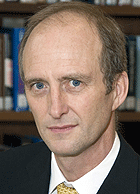Colin G. Nichols, Ph.D., has been named the first Carl F. Cori Professor at the School of Medicine.
Nichols, professor of cell biology and physiology, studies molecules on the surfaces of cells known as ion channels. These channels let charged particles pass into and out of cells and play critical roles in physiological processes from thoughts to movement.
The Carl F. Cori professorship is named in honor of a University faculty member who shared the Nobel Prize for Medicine with his wife and fellow faculty member, Gerty Cori, in 1947. They received the prize for their studies of the control of sugar metabolism.

The professorship is the third of an initial group that has been endowed as a component of the University’s BioMed 21 initiative, which is dedicated to quickly translating laboratory discoveries into new approaches for patient diagnosis and treatment.
“Colin Nichols’ work is very basic research that has helped bring about a dramatic change in the clinical treatment of neonatal diabetes,” said Larry J. Shapiro, M.D., executive vice chancellor for medical affairs and dean of the School of Medicine. “He in turn has used data from the clinic to refine his research, and that’s just the kind of bench-to-bedside synergy we want to promote via BioMed 21.”
Two other BioMed 21 professorships, also named for University faculty members who won Nobel Prizes, were awarded in 2006. Endowments for these chairs were donated by John F. McDonnell and the JSM Charitable Trust Foundation. McDonnell, the younger son of honored aerospace pioneer James S. McDonnell, is vice chairman of the University’s Board of Trustees and has served on the board since 1976.
Nichols came to WUSTL in 1991 from joint appointments at Baylor University and the University of Maryland, Baltimore. He became a full professor of cell biology and physiology in 2000.
“It’s a little daunting to think what this new Cori professorship means, but it’s also a great honor,” Nichols said.
His laboratory uses computer, cellular and animal models to probe the structure, function and regulation of ion channels, which can change the way cells function by controlling their electrical polarity. For example, he has selectively expressed these channels in a mouse’s heart tissue and used them to model the electrical derangements that occur in heart arrhythmias.
Six years ago, Nichols mutated an ion channel active in the pancreas of mice and predicted the mutations’ effects would lead to diabetes in the mice. After finding that it did so quite dramatically, he suggested the gene for the channel was likely to play a role in human diabetes. Later, other researchers confirmed this hypothesis, leading to a change in scientists’ understanding of what causes neonatal diabetes. As a result, the condition now is treated differently, with a daily pill instead of three-times-daily injections of insulin.
Nichols is the president of the Society of General Physiologists and a fellow of the American Heart Association. He is a member of the Biophysical Society, the Juvenile Diabetes Foundation, the American Heart Association Basic Science Council and the American Diabetes Association.
Nichols also is a member of the Cori Society, a University organization that promotes informal interactions between students and faculty.